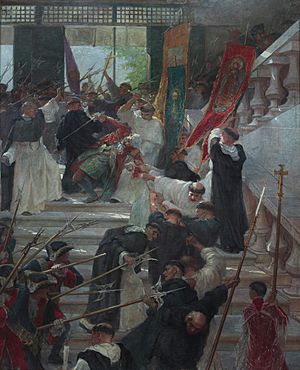Fernando Manuel de Bustillo Bustamante y Rueda facts for kids
Quick facts for kids
Su Excelencia
Fernando Manuel de Bustillo Bustamante y Rueda
|
|
|---|---|
 |
|
| Field Marshal of the Spanish Empire | |
| In office August 9, 1717 – October 11, 1719 |
|
| Preceded by | Martín de Urzua y Arismendi |
| Succeeded by | Francisco de la Cuesta |
Fernando Manuel de Bustillo Bustamante y Rueda was an important leader in the Philippines. He served as the 37th Governor-General of the Captaincy General of the Philippines. This was a big job, like being the top leader of the country. He held this position from 1717 until he died in 1719.
Contents
Becoming Governor-General
Fernando Bustamante was often called mariscal, which means marshal. He was the first field marshal to become governor of the Philippine Islands. Before this, he was a local leader, an alcalde mayor, in a place called Trascala in Nueva España. Today, this area is part of Mexico.
He was chosen to be governor on September 6, 1708. He finally arrived in Manila, the capital, on August 9, 1717. People thought he was very strict in his decisions. He also helped bring back the military base in Zamboanga in 1718.
Challenges with the Church
Governor Bustamante faced many challenges with the Church. Some people who had committed crimes tried to hide in churches. This was called "church asylum" or "sanctuary." The Governor wanted these people to face justice.
The Archbishop of Manila, Francisco de la Cuesta, was the head of the Church. He believed that churches were special places where civil laws did not apply. He refused to hand over the people hiding there. At the same time, some citizens who supported the Archbishop started to work against the Governor.
A Judge's Return
A former acting-governor named José Torralba had been accused of misusing a lot of money. Governor Bustamante released him from prison. He even made Torralba a judge in the Supreme Court again. The Archbishop strongly disagreed with this. He told Torralba that he was no longer part of the Church, a serious punishment called excommunication.
Torralba, now a judge, quickly tried to get back at his opponents. Many of them then sought safety in churches, just like others before them. With the Archbishop's support, they felt safe from Torralba's actions.
Conflict at the Cathedral
The situation became very tense. The Governor's soldiers entered Manila Cathedral. This was a big problem because it broke the rule of church sanctuary. The Governor had ordered them to get back important government papers held by a public official hiding in the Cathedral.
The Archbishop asked experts from the Real Universidad de Santo Tomás for their opinion. These experts, who followed canon law (church law), said that civil authorities could never enter sacred places. This was true even if the Governor or the high court ordered it.
Because of these problems, Archbishop De la Cuesta was arrested and put in prison. Many Dominican priests and other church leaders who supported him were also arrested.
Governor Bustamante's Death
People were very upset about the Archbishop being in prison. They were also angry that the government did not respect churches as places of safety. A large group of the Archbishop's supporters rushed into the Palacio de Gobernador, which was the Governor's palace. During this event, Governor Bustamante was killed.
After his death, Archbishop De la Cuesta was released from prison. He then became the acting Governor-General.
In Art
A famous painting by Félix Resurrección Hidalgo shows this event. It is called The Assassination of Governor Bustamante. You can see it at the National Art Gallery in the National Museum. The painting shows a crowd of Dominican priests pulling the governor down the palace stairs.
However, a Spanish historian named Fr Fidel Villarroel believes this painting might not be completely accurate. He says that Hidalgo might have been given wrong information. He thinks that the priests were not actually involved in the murder. In fact, he says all the priests were in prison with the Archbishop when it happened.
See also
 In Spanish: Fernando Manuel de Bustamante Bustillo y Rueda para niños
In Spanish: Fernando Manuel de Bustamante Bustillo y Rueda para niños


